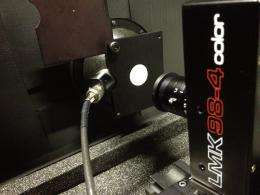Improving light and heat spectra measurements

Whether you want to investigate objects in space, characterize the quality of light sources, optimize photovoltaics modules or analyze chemical compounds, measuring the spectrum of light- or heat sources is often the method of choice. Conventional procedures thereby generate radiation distribution curves which are distorted and have to be subsequently corrected. The Physikalisch-Technische Bundesanstalt (PTB) has now developed a mathematical procedure which yields clearly improved results and can be applied in numerous fields of radiometry and photometry. The software required can be downloaded free of charge from PTB's website.
Measuring systems for optical or thermal radiation such as, e.g., radiometers, spectrometers and photometers, generate spectral distribution curves which shed light on the characteristics of the measured radiation (e.g. its luminance, its colour quality, its temperature or its wavelength). These distribution curves, however, exhibit distortions which are caused by the measuring instrument used. There are correction procedures, but these are reliable to a certain extent only. Scientists at PTB have found a new approach to this problem: they have, for the first time, considered the occurring distortions as mathematical convolution and used the Richardson-Lucy method - an iterative procedure - for the deconvolution.
An issue which has often been discussed with regard to the Richardson-Lucy method is the need for a criterion for the breaking of the iterations. In this context, a novel approach has been developed at PTB which works, in principle, automatically and independent of additional parameters. This new approach has turned out to be very robust, both in comprehensive simulations and in investigations of measurement data. The scientists hereby investigated numerous scenarios with diverse line spread functions and signal-to-noise ratios. The procedure developed in this way is suitable both to improve broadband spectral distribution curves (as occurring, e.g., in heat radiators) and narrowband distribution curves (as occurring in LEDs).
More information: Eichstädt, S. (2013). Comparison of the Richardson-Lucy method and a classical approach for spectrometer bandpass correction, Metrologia 50, 107 - 118.
Journal information: Metrologia
Provided by Physikalisch-Technische Bundesanstalt


















